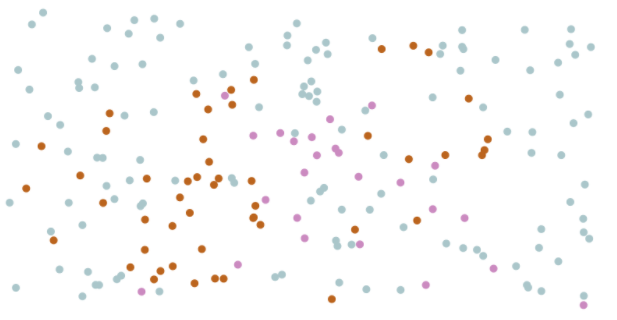Browse By Unit
ACT Math: Integrating Essential Skills: Modeling
5 min read•june 18, 2024
Mick Polito
Mick Polito

Image Taken From washingtonpost.com
Modeling is a vital part of mathematics that involves taking information about a situation and building a diagram, graph, or model to represent the situation to study it. Modeling often involves simulating processes to investigate potential outcomes and make decisions (see the infamous "Flatten The Curve" article from March 2020) and is also a large part of the ACT math section, as several questions involved modeling and interpreting these models. Modeling accounts for approximately 27% of the ACT Math section, and these questions are within other sections, such as Algebra, Functions, Geometry, and Statistics/Probability.
Review Materials: ACT Math: Geometry, ACT Math: Algebra and Functions, ACT Math: Statistics and Probability
📍 Modeling with Diagrams
The first thing you may encounter on the ACT is modeling with a diagram. One of the most common questions you may see here could involve a word problem with a diagram.
😵 Word Problems
For many math students, word problems are often very overwhelming. Fortunately, we have some great tips for test-takers that can make these problems not so overwhelming:
-
- Consider drawing a picture if there isn't one already! Images often provide a better way of solving the problem than just relying on the words in the problem.
-
- Highlight keywords or phrases. Highlighting or underlining keywords or phrases allows you to understand what the question is asking for and avoid getting caught up in irrelevant information.
-
- Eliminate wrong answers. Process of elimination is your friend when taking the ACT, especially in the Math section, and many times, you can eliminate answer choices that are not the answer simply because they do not make sense in the context of the problem.
🤓 Example Problem
A 17-ft ladder is leaning against a tree. If the climber is trying to reach something 15 feet up the tree (with the top of the latter reaching exactly 15 feet, how far will the base of the ladder need to be from the tree to reach the item in the tree? (Don't peek at the answer! Work it out yourself to test your skills!)
This problem is an excellent opportunity to draw a diagram. When you sketch out the diagram, you will see that it makes a right triangle where the ladder is the hypotenuse. From there, it is a simple Pythagorean Theorem question where we find the answer to be 8 feet because 17 squared (289) minus 15 squared (225) equals 64, the square of 8.
📊 Modeling with Graphs

It is no mystery that graphs are an essential part of mathematics and will appear on the ACT. The most important thing about handling questions with graphs is interpreting graphs and calculating key features from a graph or data.
🔢 Algebra
The first type of graph common to the ACT is your typical Cartesian coordinate plane. These problems typically involve finding slope or other features about the graph and how these tell us more about the situation described.
For instance, there may be a graph showing how far a car has traveled within the last 4 hours, asking us to find the average speed of the car. When asking for the speed when given the distance graph, we would need to find the slope by calculating how far the car traveled total and dividing by the time of 4 hours.
🔣 Probability
Another type of graph the ACT includes is data breakdowns such as pie charts, bar graphs, and frequency charts. These graphs are often models of a given set of data where you may have to calculate the probability of randomly selecting a given outcome.
For example, let's say you have a bag of ten marbles, 5 blue and 5 red. What is the probability of you picking a blue marble, replacing that marble, and then picking a red marble. Remembering our probability rules, we can deduce that firstly, there is a fifty percent chance of you picking the blue marble. Then, there is also a fifty percent chance of you picking the red marble (remember that the blue marble was placed back in the bag). Given that, there is a twenty-five percent chance of the sequence of events occurring.
✏️ Improving Models
Modeling is the act of using mathematics to simulate and accurately predict outcomes. Since we usually use modeling to predict outcomes, the models must be as robust and efficient as possible.
In a construction project, contractors want to design their projects to use materials and time as efficiently as possible. Many times, this may be by thinking about the situation mathematically.

📐 Geometry
One of the most common modeling concepts in which we are looking at improving outcomes is in the Geometry section of the test. One of the key things to know in the geometry section is how to calculate area and perimeter.
To find the area of a rectangle, square, or parallelogram, use the formula A=bh (where A equals area, b equals base measurement, and h equals height measurement). If you need to find the area of a triangle, use the formula A=1/2bh. You can easily find the perimeter by adding up all the lengths of the sides of a shape. In terms of construction, both area and perimeter can save contractors money and materials when taking advantage of materials already available.
🤓 Example Problem
ABC Construction Company has 42 feet of fence to construct a dog park area at a local truck stop. To maximize the area available for the 🐕, they have decided to use one side of the building, so only three sides have to use the fence to close in the area. What is the maximum area that the builders can create? (Once again, try it out on your own before reading the explanation! Trust us, it may be tough, but it's good for you!)
Since our fence will only have two lengths and one width, our perimeter formula can be altered to be 2l+w=42. Therefore, our width will be 42-2l. We can take that formula and plug it into our area of a rectangle formula A=lw=l(42-2l). We now have a quadratic equation in which we can find the maximum to occur at a length of 10.5 feet. Therefore, our width will be 21, so our maximum area will be 220.5 square feet. This question is a GREAT opportunity to discuss some of our strategies for word problems like above. It is super helpful to draw a picture of the scenario to get a better handle on how to solve this. Also, it might be helpful to work this problem out backward by using process of elimination from answer choices that do not make sense (like answers that are clearly too large or small), or if you have the dimensions, eliminating those that do not work with the fence perimeter or give us a small area.
Great work, you've made it through the Modeling section of our ACT Math Review! Continue studying for the ACT Math with us by checking out our other lessons. You've got this!
<< Hide Menu
ACT Math: Integrating Essential Skills: Modeling
5 min read•june 18, 2024
Mick Polito
Mick Polito

Image Taken From washingtonpost.com
Modeling is a vital part of mathematics that involves taking information about a situation and building a diagram, graph, or model to represent the situation to study it. Modeling often involves simulating processes to investigate potential outcomes and make decisions (see the infamous "Flatten The Curve" article from March 2020) and is also a large part of the ACT math section, as several questions involved modeling and interpreting these models. Modeling accounts for approximately 27% of the ACT Math section, and these questions are within other sections, such as Algebra, Functions, Geometry, and Statistics/Probability.
Review Materials: ACT Math: Geometry, ACT Math: Algebra and Functions, ACT Math: Statistics and Probability
📍 Modeling with Diagrams
The first thing you may encounter on the ACT is modeling with a diagram. One of the most common questions you may see here could involve a word problem with a diagram.
😵 Word Problems
For many math students, word problems are often very overwhelming. Fortunately, we have some great tips for test-takers that can make these problems not so overwhelming:
-
- Consider drawing a picture if there isn't one already! Images often provide a better way of solving the problem than just relying on the words in the problem.
-
- Highlight keywords or phrases. Highlighting or underlining keywords or phrases allows you to understand what the question is asking for and avoid getting caught up in irrelevant information.
-
- Eliminate wrong answers. Process of elimination is your friend when taking the ACT, especially in the Math section, and many times, you can eliminate answer choices that are not the answer simply because they do not make sense in the context of the problem.
🤓 Example Problem
A 17-ft ladder is leaning against a tree. If the climber is trying to reach something 15 feet up the tree (with the top of the latter reaching exactly 15 feet, how far will the base of the ladder need to be from the tree to reach the item in the tree? (Don't peek at the answer! Work it out yourself to test your skills!)
This problem is an excellent opportunity to draw a diagram. When you sketch out the diagram, you will see that it makes a right triangle where the ladder is the hypotenuse. From there, it is a simple Pythagorean Theorem question where we find the answer to be 8 feet because 17 squared (289) minus 15 squared (225) equals 64, the square of 8.
📊 Modeling with Graphs

It is no mystery that graphs are an essential part of mathematics and will appear on the ACT. The most important thing about handling questions with graphs is interpreting graphs and calculating key features from a graph or data.
🔢 Algebra
The first type of graph common to the ACT is your typical Cartesian coordinate plane. These problems typically involve finding slope or other features about the graph and how these tell us more about the situation described.
For instance, there may be a graph showing how far a car has traveled within the last 4 hours, asking us to find the average speed of the car. When asking for the speed when given the distance graph, we would need to find the slope by calculating how far the car traveled total and dividing by the time of 4 hours.
🔣 Probability
Another type of graph the ACT includes is data breakdowns such as pie charts, bar graphs, and frequency charts. These graphs are often models of a given set of data where you may have to calculate the probability of randomly selecting a given outcome.
For example, let's say you have a bag of ten marbles, 5 blue and 5 red. What is the probability of you picking a blue marble, replacing that marble, and then picking a red marble. Remembering our probability rules, we can deduce that firstly, there is a fifty percent chance of you picking the blue marble. Then, there is also a fifty percent chance of you picking the red marble (remember that the blue marble was placed back in the bag). Given that, there is a twenty-five percent chance of the sequence of events occurring.
✏️ Improving Models
Modeling is the act of using mathematics to simulate and accurately predict outcomes. Since we usually use modeling to predict outcomes, the models must be as robust and efficient as possible.
In a construction project, contractors want to design their projects to use materials and time as efficiently as possible. Many times, this may be by thinking about the situation mathematically.

📐 Geometry
One of the most common modeling concepts in which we are looking at improving outcomes is in the Geometry section of the test. One of the key things to know in the geometry section is how to calculate area and perimeter.
To find the area of a rectangle, square, or parallelogram, use the formula A=bh (where A equals area, b equals base measurement, and h equals height measurement). If you need to find the area of a triangle, use the formula A=1/2bh. You can easily find the perimeter by adding up all the lengths of the sides of a shape. In terms of construction, both area and perimeter can save contractors money and materials when taking advantage of materials already available.
🤓 Example Problem
ABC Construction Company has 42 feet of fence to construct a dog park area at a local truck stop. To maximize the area available for the 🐕, they have decided to use one side of the building, so only three sides have to use the fence to close in the area. What is the maximum area that the builders can create? (Once again, try it out on your own before reading the explanation! Trust us, it may be tough, but it's good for you!)
Since our fence will only have two lengths and one width, our perimeter formula can be altered to be 2l+w=42. Therefore, our width will be 42-2l. We can take that formula and plug it into our area of a rectangle formula A=lw=l(42-2l). We now have a quadratic equation in which we can find the maximum to occur at a length of 10.5 feet. Therefore, our width will be 21, so our maximum area will be 220.5 square feet. This question is a GREAT opportunity to discuss some of our strategies for word problems like above. It is super helpful to draw a picture of the scenario to get a better handle on how to solve this. Also, it might be helpful to work this problem out backward by using process of elimination from answer choices that do not make sense (like answers that are clearly too large or small), or if you have the dimensions, eliminating those that do not work with the fence perimeter or give us a small area.
Great work, you've made it through the Modeling section of our ACT Math Review! Continue studying for the ACT Math with us by checking out our other lessons. You've got this!

© 2025 Fiveable Inc. All rights reserved.